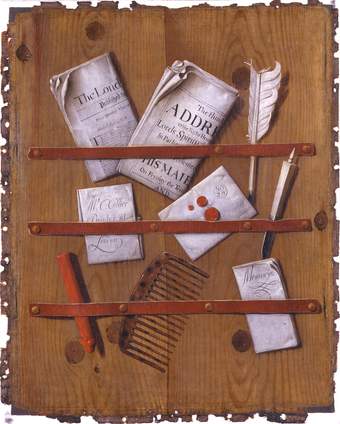
Fig.1
Edward Collier active 1662–1708
A Trompe l’Oeil of Newspapers, Letters and Writing Implements on a Wooden Board c.1699
T03853
The original tacking edges were incorporated into the picture plane during the restoration of 1985
This painting is in oil paint on canvas measuring 588 x 462 mm (fig.1). The support is a single piece of plain woven canvas. The thickness of the threads is variable and the weave a little uneven; there are approximately 15 vertical threads and 9 horizontal per square centimetre. An X-radiograph would be uninformative about the canvas due to the larger aluminium honeycomb panel that was marouflaged to the back of the previously unlined painting in 1985, and which would dominate the image. Before that date the painting was attached with hand-made nails to a four-member strainer made of pine with nailed, half-lap joints. The front face of this strainer was chamfered; its bars were between 38 and 45 mm (1 ½ and 1 ¾ ins) wide and approximately 12 mm (½ inch) thick. A very similar strainer exists on the unlined painting of John Banckes of 1676 by Sir Godfrey Kneller (T05019).
The tacking edges are extant on the painting, with the pinkish grey ground extending across their entire width. There is cusping evident on the primed tacking edge at the left and bottom but not on the other two edges or in the picture plane, suggesting that a large piece of canvas was laced onto a strainer for priming and then cut to fit the painting’s strainer.1
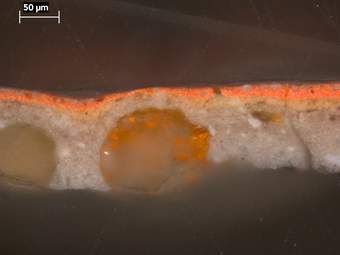
Fig.2
Cross-section taken from the red sealing wax candle, 124mm from the left edge and 148mm from the bottom, and photographed at x320 magnification. From the bottom of the sample upwards: pinkish grey ground, average thickness 80 microns. It contains two large lead soap aggregates that apparently include mineralised red lead though in fact this may lie beneath the rather transparent aggregate; opaque yellow paint of trompe l’oeil wooden background; red paint of candle; varnish
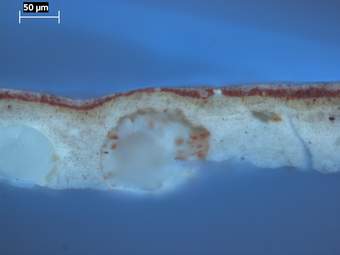
Fig.3
The same cross-section as in fig.2, photographed at x320 magnification in ultraviolet light

Fig.4
Infrared photograph of A Trompe l’Oeil of Newspapers, Letters and Writing Implements on a Wooden Board
The ground is a pinkish grey colour and contains lead white, chalk, black and earth pigments, all bound together in oil.2 It was thickly applied and seeped through to the back of the canvas in places during application. The ground contains large lead soap aggregates with the formation of associated red lead (figs.2– 3), which indicates that its medium must be oil-based. No priming was applied to the ground, nor was any underdrawing apparent in an infrared photograph (fig.4).
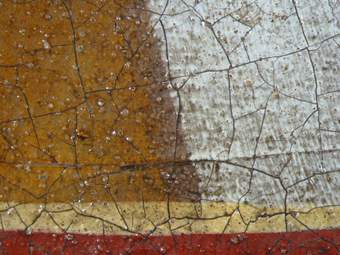
Fig.5
Photomicrograph at x0.8 magnification of the reserve left for the ‘Memorye’ document
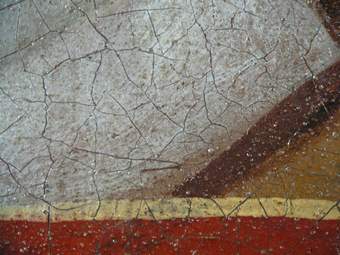
Fig.6
Photomicrograph at x0.8 magnification of the reserve left for the letter with the red seal
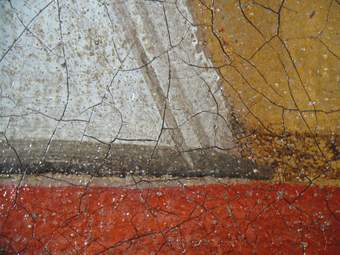
Fig.7
Photomicrograph at x0.8 magnification of the reserve for uppermost band of red tape on the newspaper
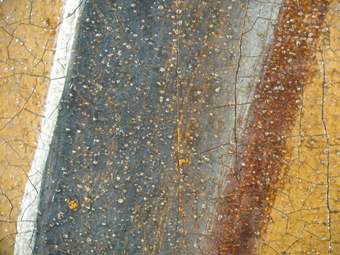
Fig.8
Photomicrograph at x0.8 magnification of the blade of knife painted over the yellow background
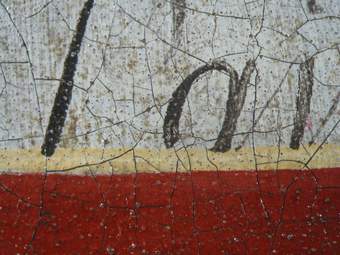
Fig.9
Photomicrograph at x0.8 magnification of the inscription and the highlighted edge of the red tape
The paint, opaque and medium-rich, was applied thinly with little visible brushwork or impasto. The yellow of the trompe l’oeil wooden background was mixed from lead white, lead-tin yellow, orpiment, vermilion, chalk, glassy particles, black and sienna. The composition was laid down very systematically with reserves left for the major elements, such as the documents and the tape, with other elements, the shading and the details added later (figs.5–9).
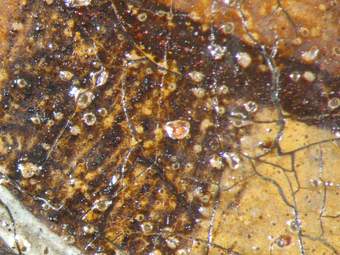
Fig.10
Photomicrograph at x1.6 magnification of the lead soap aggregates with associated red lead in the comb
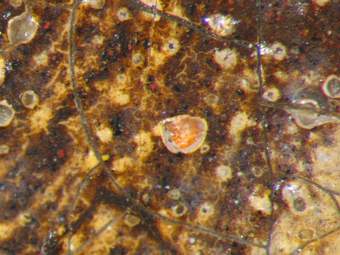
Fig.11
Photomicrograph at x3.2 magnification of the lead soap aggregates in the comb
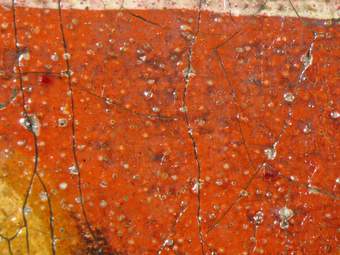
Fig.12
Photomicrograph at x0.8 magnification of the remains of a red lake glaze on lowest band of red tape
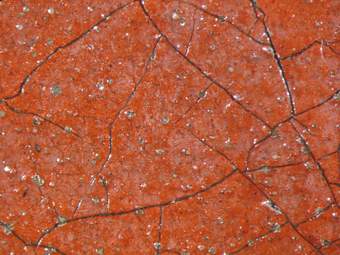
Fig.13
Photomicrograph at x10 magnification of blanching at the surface of the red tape
The entire picture surface is disrupted with lead soap aggregate formation (figs.5–13). These tiny spherical aggregates have developed in the ground, and then expanded until they have broken through the paint surface. There is evidence that the bands of opaque red tape were once glazed with a translucent red lake (fig.12). At high magnification grey discolouration can be discerned on the surface of the red tape; this may be blackening of vermilion (fig.13), which is a separate type of chemical alteration.
A considerable amount of surface dirt and discoloured varnish was removed in 1985, after which the painting was varnished with and retouched in Paraloid B-72 acrylic resin.
August 2020
